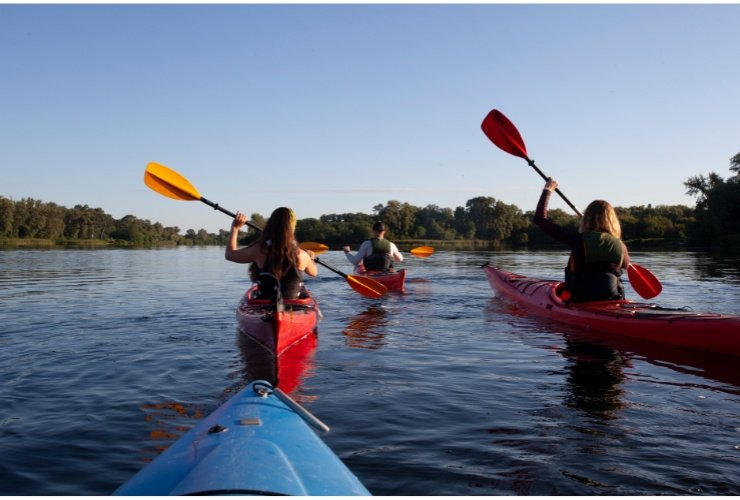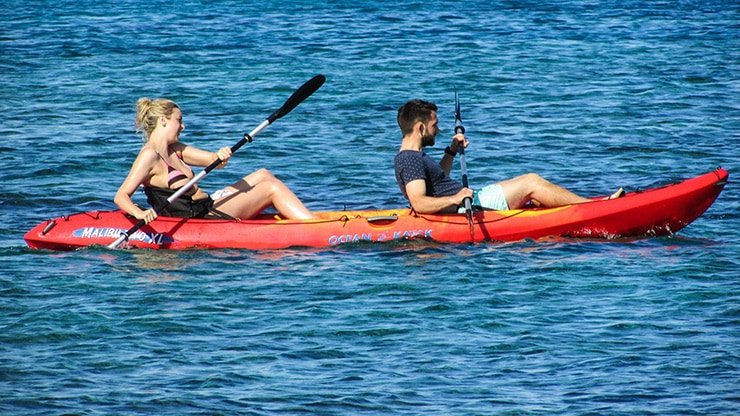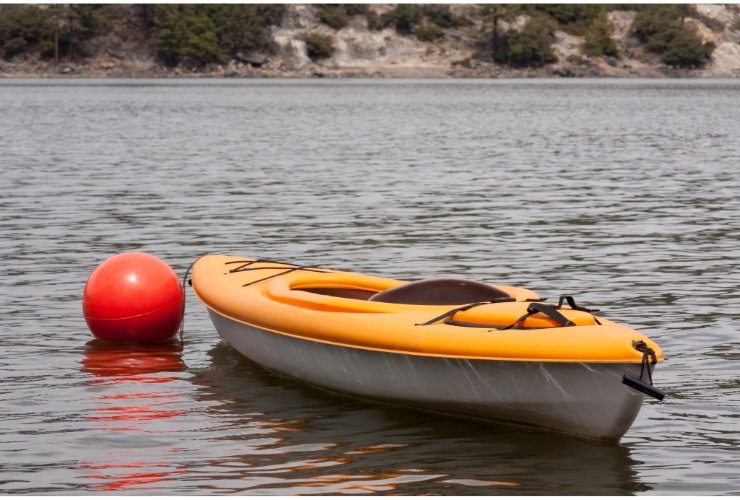Depending on your favorite way to kayak, it’s possible that, at some point, you will need to bump up the amount of weight it can carry. If you’re wondering how to increase your kayak’s weight capacity, the good news is that several options are open to you.
This guide will cover what you can do to help you decide what works for you.
Key Takeaways
- You can increase your kayak’s weight capacity by either changing how you use it or by adding floats and other equipment to improve stability and buoyancy.
- Some kayaks are more stable and can hold more weight than others; fishing kayaks and inflatable kayaks are nearly always the best picks in this regard.
- Don’t forget that a kayak’s max weight capacity is not the only thing you need to account for – the performance weight limit is even more important!
Is it Really Possible to Increase a Kayak’s Weight Capacity?
Improving weight capacity usually falls under one of two categories. You can modify your kayak’s structure or change how you use your kayak – depending on your limitations and the limits of your hull.
To boil down all the options you have available into one bitesize package – you can do the following:
- Be smart about location: stick to calmer waters
- Paddle correctly: change your paddling technique to deal with more weight
- Use specialized equipment: use equipment like airbags and outriggers to enhance stability
- Customize your kayak: you can add a bulkhead to your kayak, invest in a different hull, or find another kayak altogether
What Can I Do to Make My Kayak Carry More Weight?
Before you make any changes to your kayak, you should consider what you can do to paddle with more weight. Let’s take a look at how you can modify your behavior to make the best of your kayak’s weight capacity.
Doing so will allow you to eke out more performance or give you greater peace of mind if you’re hovering a bit too close to the max capacity your kayak can handle.
Choose the Best Water Conditions For Carrying Extra Weight

Water conditions go a long way towards helping your kayak stay upright, and this becomes true the more weight your kayak carries.
When your kayak isn’t burdened by tons of weight, it can stay buoyant even on turbulent waters.
However, when you’re at or near your max weight limit and in motion through waves and strong currents, that water can enter your cockpit and force your kayak down. You’ll either need to get out and abandon ship or bail the water out before it sinks you.
Being on calmer waters completely negates this problem – the water isn’t getting into your cockpit and isn’t going to sink you.
Also, calm coastal waters are by far the best option, as salt water is more buoyant than fresh water. In truth, though, there isn’t much difference between a placid lake and calm coastal waters.
Learn the Paddling Techniques That Keep You Stable
Good, efficient paddling technique is another important behavior modification for anyone operating a kayak at or near weight capacity.
Good paddling technique is all about keeping stable and propelling yourself efficiently. Whereas bad paddling technique is all about sacrificing form for more speed – while you can get away with this when you don’t have weight, it’s a different story when you’re loaded up.
Poor paddling technique causes rocking and side-to-side motion, which can quickly lower your stability. It can also cause a kayak to flip if you’re at your weight capacity. Typically kayaks are very stable, but the relation between weight and stability means that if one goes up, the other goes down.
Check out this guide on paddling techniques to learn more.
Practical Ways to Increase Your Kayak’s Weight Capacity
The second part of boosting kayak weight capacity pertains to the things that you can control or change about the kayak or hull. Much of this is about boosting stability – if your kayak is more stable, it can handle more weight.
It’s important to note there’s only so much you can do to boost the weight capacity with accessories and equipment.
Enhance Stability With Specialized Equipment
You can use several pieces of equipment to help increase your kayak’s weight capacity.
- Airbags – These can contain helium and will help you float on the water.
- Kayak Stabilizers – These can be inflatable or fixed to your kayak and are a great way to increase weight capacity.
- Use an Outrigger – Outriggers add support to the hull. However, they must be installed correctly or may be more harmful than helpful.
- Pool Noodles – These can be a simple solution to boosting stability and adding a couple of pounds to your weight capacity. They help keep your kayak floating, which suppresses some of the harmful effects of extra weight.
Add a Bulkhead to Your Kayak
Another way to increase weight capacity is to install a bulkhead – this can be made from various materials, most commonly foam and fiberglass. There isn’t much difference between these materials, but fiberglass is nearly always sturdier.
Bulkheads add an element of ease of use as they can add compartments to store kayak gear that will be both air-tight and watertight. They can help protect the cock pit from water getting in, and this boost in stability adds to weight capacity.
Choose a Kayak Hull That’s Designed To Bear More Weight
While the equipment mentioned above can add directly to a kayak’s weight capacity, the single best thing you can do is invest in a hull designed to maximize stability and bear weight.
A fishing kayak is the perfect hull frame for anyone looking for the highest kayak weight limits. A fishing kayak can be designed with pontoons that add further stability and anything you do to increase weight capacity on any kayak will work best on fishing kayaks.
Understanding the Relationship Between Buoyancy and Weight

Buoyancy is a vessel’s capacity to float on water – the more buoyant something is, the more weight it can support on the water. Much of the above measures are about making your kayak as buoyant as possible.
The closer you are to the kayak’s maximum weight capacities, the more you need to pay attention to buoyancy. Overloaded kayaks lose some buoyancy and stability, and changes in water conditions they would normally easily handle can become challenging.
In a nutshell, the closer you are to the kayak’s weight limit, the more you need to think about buoyancy.
How To Make a Kayak More Buoyant
Increasing buoyancy is all about adding more flotation power to your kayak. The best way to do this is with equipment designed for it; anything that helps a person float makes watercraft more buoyant::
- Pool Noodles
- Flotation Bags
- Beach Balls
All the equipment listed above is capable of increasing the buoyancy of your kayak – but you’ll need to know how to use it to make your kayak more buoyant. Using any of these objects is going to require a little bit of creativity and DIY.
So, how can pool noodles, beach balls and floatation bags help to increase the buoyancy of your kayak?
Pool Noodles
You can use duct tape, or zip tie wraps to affix pool noodles to your kayak’s hull. This is a super simple solution – simply slice them in half lengthways and attach them to the back and the front of your hull.
Flotation Bags
Flotation bags are pricey, but they are one of the easiest ways to increase your kayak’s buoyancy. These are thick balloon-like objects that can be attached to the spaces in your kayak’s bow (front) or stern (back).
They can be inflated to your liking to add extra buoyancy; they are the “tidiest” option here because they are designed to go into the hull structure and not be attached outside.
Beach Balls
Beach balls are inexpensive and easy to use as buoyancy aids. They can be used like flotation bags (but there is a danger of them slipping out if water enters the kayak).
Another option is to tie a rope around the beach ball and then tie that to your kayak. Not only can this look shabby, but there’s also the risk of the beach balls being snagged by obstacles in the terrain.
If all Else Fails, Find a Different Kayak
Any item that can help a person float on the water can also increase a kayak’s buoyancy, and thankfully, there’s a kayak designed explicitly with these advantages in mind. In fact, many rescue organizations and military units conducting operations in water tend to prefer this type of kayak universally.
Inflatable kayaks are made of tubes or chambers that are filled with air; this keeps the vessel floating even in rough water. The way these kayaks are constructed (with wide tubes dispersed throughout the hull) adds to the overall width, and greater width adds to stability and buoyancy.
You could double down on all these benefits with inflatable fishing kayaks – even the non-inflatable versions have good stability and weight capacity.
In a nutshell, inflatable kayaks of all kinds are very stable and buoyant out of the box. If the capacity to bear weight and keep floating easily is your primary concern, these kayaks will be your best option.
What Happens if You Exceed a Kayak’s Maximum Weight Capacity?
While most kayaks are sturdy and designed to stay on the water, an excessive amount of weight combined with the forces of nature can challenge even the most experienced kayaker.
While most manufacturers will tell you what a kayak’s maximum weight capacity is, it’s not recommended to always load up your kayak close to that capacity for extended periods.
Constantly hovering close to max weight is an excellent way to tank your kayak’s stability on the water. It makes it much more likely for your kayak to flip, and if your gear isn’t secured, it may become damaged, and even if it is, it may be difficult, if not impossible, to retrieve the sunken kayak and your gear.
Performance Weight Limit Calculation of a Kayak
The manufacturer determines the weight capacity of a kayak. However, knowing the maximum weight limit of your kayak isn’t always enough, nor is it good to be consistently hovering around it.
This is where the performance weight limit concept comes into play.
Generally speaking, the performance weight limit is 70 percent of the listed max capacity. While this is still in the higher weight range, it gives you a bit less wiggle room. Going over this means your kayak will capsize more easily, sit lower in the water, and generally not perform as well.
The calculation for max capacity is as follows:
Maximum weight capacity x 0.7 = Performance weight limit
As an example, if you had a kayak with a max capacity of 300lbs, your performance weight limit would be 210lbs.
Weighing Your Gear
One way you can get an accurate readout of how much weight your kayak has to handle is by using a hanging scale. While regular scales can be used, it means weighing everything individually and adding it all up, which takes time and often leads to unreliable results.
Packing most of your gear in a dry bag and using a hanging scale is the best way to grasp how much you’ll be carrying fully. You don’t need to buy your own either; plenty of outdoor stores have hanging scales you can use.
Also, don’t forget that any water that gets into your kayak also weighs it down. So if you’re hovering close to your kayak’s capacity and enough water gets into the cockpit, it can lead to situations where you’re way beyond the performance weight limit without realizing it.
Conclusion
There are various ways to enhance a kayak’s weight capacity, stability, and buoyancy. However, it’s important to note that there’s only so much you can do to improve weight capacity, and it’s not a great idea to overload your kayak constantly.
Thank you for reading; please like, comment, and share if you found the information here useful.

